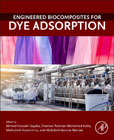
Engineered Biocomposites for Dye Adsorption
Jagaba, Ahmad Hussaini
Mohamed Kutty, Shamsul Rahman
Isa, Mohamed Hasnain
Birniwa, Abdullahi Haruna
Engineered Biocomposites for Dye Adsorption compiles and discusses applications, mechanisms, and performance evaluation of various biocomposites during dyes adsorption. The book analyses the techno-economic and life-cycle assessment of biocomposites for dye adsorption. It highlights different adsorbent materials for dyes degradation and resource recovery ranging from but not limited to activated carbon, biochar, hydrochar, pyrochar, waste fruits, waste industrial sludge, geological materials, graphene, carbon nanotubes, MXene, polymers, metals, nanomaterials, metal-organic frameworks. The book shows how combining materials as bio-composite significantly yield better dyes adsorption than a single material and addresses conventional issues with adsorption such as adsorbent cost, effectiveness, regeneration, and sustainability and provides insights into the preparation and use of new adsorbent materials for dye removal from aqueous solutions. The information contained in this book will increase readers' fundamental knowledge, guide future researchers, can be incorporated into future works on experimental studies on dye adsorption. As such it serves as an indispensable resource and reference work for engineers, wastewater specialists, biotechnologists, chemists, microbiologists, researchers, and students studying industrial effluents, biomass, bioproducts and adsorption processes. Offers a collection of state-of-the-art dye removal methods using conventional and advanced/new adsorbentsProvides detailed understanding of the methods of preparation and properties of new adsorbents and bio-compositesIncludes applications of bio-composite adsorbents in dye removal; their effectiveness & limitations, and process optimization INDICE: Section A: Introduction to dye adsorption1. Industrial dye effluents sources, generation, characteristics, and value-added products2. Impacts of dye contaminated effluents on the environment.3. Fundamentals and mechanisms of adsorption processes for dye removal4. Synthesis, modification, characterization, and applications of biocomposite materials for dye adsorptionSection B: Sustainable raw and functionalized bio-composite materials for adsorptive removal of dye5. Activated carbon and its derivative biocomposites6. Biochar, hydrochar and their derivative biocomposites7. Waste industrial sludge and its derivative biocomposites8. Agricultural wastes and their derivative biocomposites9. Geological materials and their derivative biocomposites10. Graphene and its derivative biocomposites11. Carbon nanotubes and their derivative biocomposites12. MXene and its derivative biocomposites13. Zero-valent iron and its derivative biocomposites14. Polymers and their derivative biocomposites15. Metals and their derivative biocomposites16. Nanomaterials and their derivative biocomposites17. Metal-organic framework and their derivative biocomposites18. Magnetic materials and their derivative biocompositesSection C: Techno-economic and life-cycle assessment in dye adsorption19. Modelling, optimization, and prediction using soft computing techniques for simultaneous dye adsorption and resource recovery using biocomposites20. Toxicity of biocomposites in anionic and cationic dye adsorption21. Techno-economic and life-cycle assessment of biocomposites for dye adsorption.22. Cleaner and circular bioeconomy approaches for the application of biocomposites in simultaneous dye adsorption and resource recovery23. Current policies and regulatory challenges, opportunities, and future perspectives of dye adsorption
- ISBN: 978-0-443-29877-6
- Editorial: Elsevier
- Encuadernacion: Rústica
- Páginas: 450
- Fecha Publicación: 01/01/2025
- Nº Volúmenes: 1
- Idioma: Inglés
